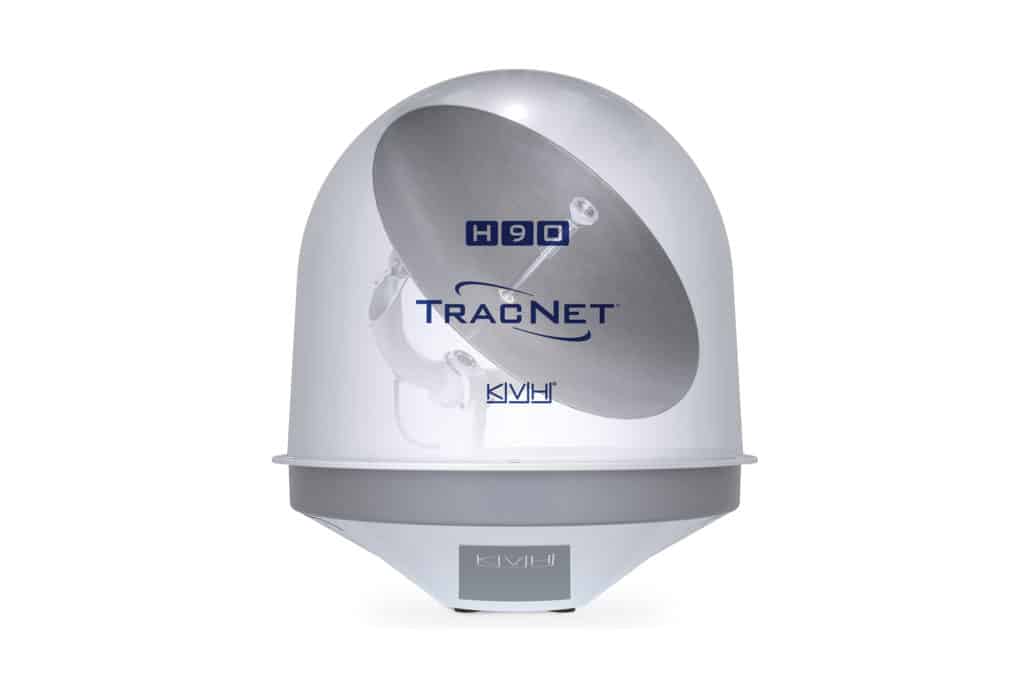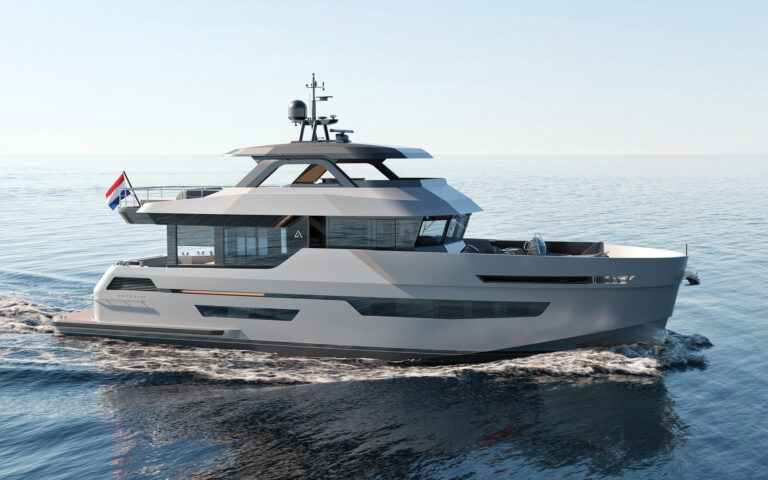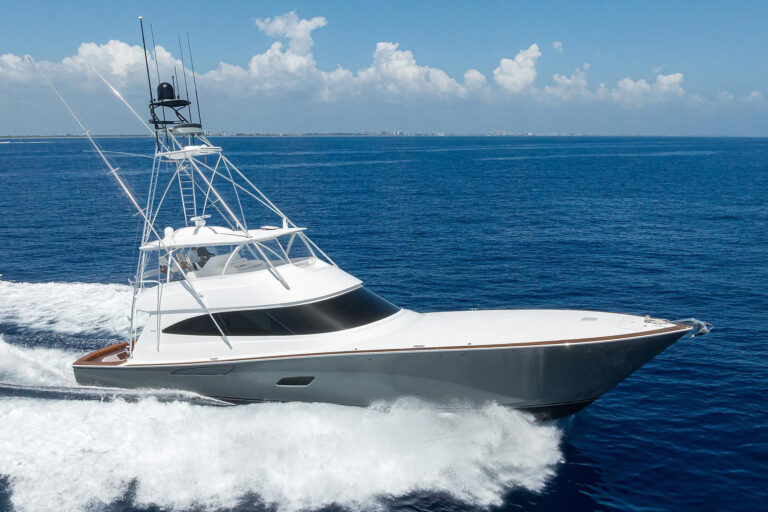
The saying goes that necessity is the mother of invention. Robert Balog, KVH’s chief technology officer, experienced this firsthand a few years ago while cruising with his wife aboard their Viking Sport Cruiser 43. The couple was berthed in Nantucket, Massachusetts. While there were 20-plus Wi-Fi hotspots ashore, none offered serviceable bandwidth. The boat’s KVH-built LTE-1 provided cellular connectivity until the ferry arrived with data-starved tourists (think concerts). The couple could use their KVH-built satcom system, of course, but this was a more expensive option than shore-based cellular or Wi-Fi.
That’s when necessity met innovation as Balog pondered how a single radome could deliver next-generation connectivity.
After almost four years of hardware and network development, his idea is here. While these technologies aren’t new, KVH’s TracNet H-series terminals, which operate exclusively on KVH’s ONE hybrid network, are the first to bundle cellular, satcom and Wi-Fi antennas into one system.
In 2021, KVH unveiled its V30 satcom system, which operates on KVH’s HTS network and has ground-up architecture. This architecture is centered around an Ethernet-power-over-coaxial (EPOC) cable that shuttles data between the antenna and the system’s rack-mounted belowdecks unit (BDU) at a rate of 1,000 megabits per second (Mbps). To put this cable into perspective, V30 units transmit and receive data at up to 2 and 6 Mbps, respectively. That leaves a lot of untapped bandwidth.
Fast-forward a year, and KVH recently released its H30 ($20,000), H60 ($28,000) and H90 ($45,000) systems. The “H” stands for hybrid, referring to the ability to communicate via cellular, satcom or Wi-Fi. All three radomes have single-cable installation, allowing the stabilized satcom antenna to articulate freely inside the radome via a commercial-grade rotary joint that eliminates cable-wrap worries. All three send data to their BDU via a super-fast EPOC pipeline.
The single-channel H30 uses a 37-centimeter aluminum dish that’s stabilized across two axes. It can send and receive satcom data at up to 2 and 6 Mbps, respectively. The dual-channel H60 employs a 60 cm aluminum dish that’s stabilized across three axes. It sends and receives data via its high-speed connection at up to 3 and 10 Mbps, while its unlimited-use channel (read: crew and guests) delivers data at up to 3 and 8 Mbps. The H90 uses a 1-meter carbon-fiber dish that’s stabilized across three axes; it transmits and receives satcom data on its high-speed channel at up to 3 and 20 Mbps, while its unlimited-use channel delivers speeds up to 3 and 8 Mbps.
H60 and H90 customers seeking faster download speeds can select KVH’s Elite network, which yields speeds up to 25 Mbps (H60) and 40 Mbps (H90).
Additionally, all three systems bundle high-gain 5G/LTE and Wi-Fi antennas and radios in their radomes. This “modem in the dome” architecture is critical because cellular and Wi-Fi work on a line-of-sight basis, so having the antennas mounted up high enables better performance than systems with rail-mounted or belowdecks antennas. The radome-mounted cellular-communications equipment contains a built-in SIM card, and the BDU has an additional two SIM slots, one of which can be used by customers who want to purchase third-party cellular connectivity (say, for cruising the Bahamas). And Balog says the EPOC cable doesn’t suffer typical radio-frequency signal loss between the radome and the BDU.
All H-series systems run their cellular, satcom and Wi-Fi connections as discrete virtual local area networks (VLANs). “The [BDU] box has access to all three [VLANs], and the box decides which to use,” Balog says, adding that the BDUs employ a form of artificial intelligence to ensure lowest-cost data routing. “There’s a rules-based AI that’s looking at things like trends,” he says. The system attempts Wi-Fi connectivity first, then cellular, then satcom. “It ranks connectivity and calculates a score for each connection,” he says. “If it sees [this score] sliding, it will change connections.”
Each BDU includes a display with an intuitive graphical user interface that gives at-a-glance information about the system’s connectivity status.
H-series antennas operate exclusively on KVH’s ONE hybrid network. Satellite communications are handled by KVH’s proprietary network, while KVH partners with a global carrier for SIM cards and 5G/LTE airtime. Wi-Fi connectivity is provided locally and, like with smartphones, is typically free. Users pay a single monthly bill to KVH for their cellular and satellite communications.
Balog says it took KVH’s engineers three and a half years to create the H-series systems and ONE network. “Both were equally challenging,” he says. “We have equal-size teams working on both. It’s a mixture of hardware and software. There was nothing commercially available that could get it done, so we built all [the hardware] in-house.”
While KVH can’t optimize traffic over cellular and Wi-Fi networks the way it can with its own satcom network, Balog says the company still monitors third-party metrics, including packet loss, latency and jitter, to ensure a good user experience.
Cybersecurity is a growing concern, and KVH took big strides with the V30. This same thinking about building in protections went into the H-series antennas. “We incorporated state-of-the-art cybersecurity, from the lowest level of the bios all the way through the network security,” Balog says. “It’s so protected that even if a hacker had the box in hand, took it apart, and flashed code to change the antenna to get into the [KVH] network, it won’t run.” H-series cybersecurity includes encrypted system-level internal communications; interested owners can optionally build even taller cyber walls.
Balog says customers should see strong Wi-Fi performance with this setup, even on notoriously bad marina Wi-Fi networks. He cited a recent visit to Newport, Rhode Island, where he realized speeds of 60 to 70 Mbps using his H60 over a marina Wi-Fi network; the speed (or really, lack thereof) plummeted to less than 10 Mbps when he bypassed the H60 and just used his iPhone.
So, if you’re interested in bolstering your onboard communications and like the idea of an end-to-end satellite-communications network that’s piggybacked with cellular and Wi-Fi communications, KVH’s latest offerings are worth considering. The gains can be huge (pun intended), even if a ferry full of data-hungry tourists arrives just as you’re settling in for some après web surfing.
Rack-Mounted Cybersecurity
While KVH’s TracNet systems provide robust cybersecurity, yacht owners seeking enterprise-grade network security could consider adding a FortiNet firewall. This rack-mounted white box and attached subscription service ($250 per month) works with KVH’s hardware and network, and can, among other capabilities, determine whether an infected device is attempting to join a network.









